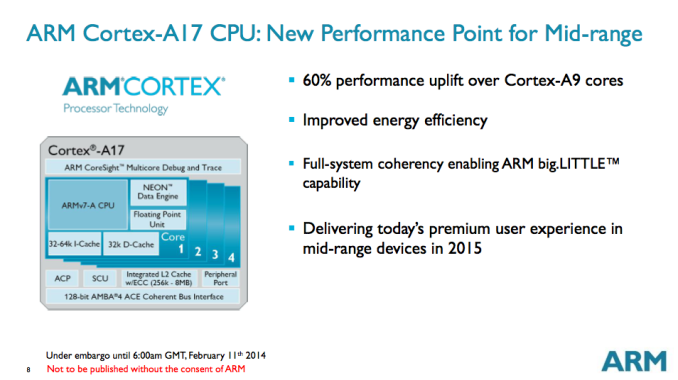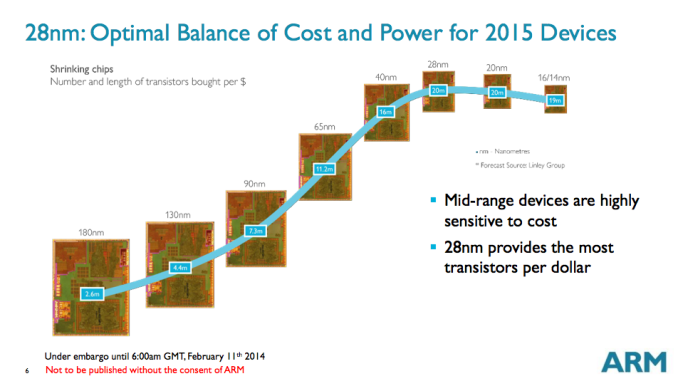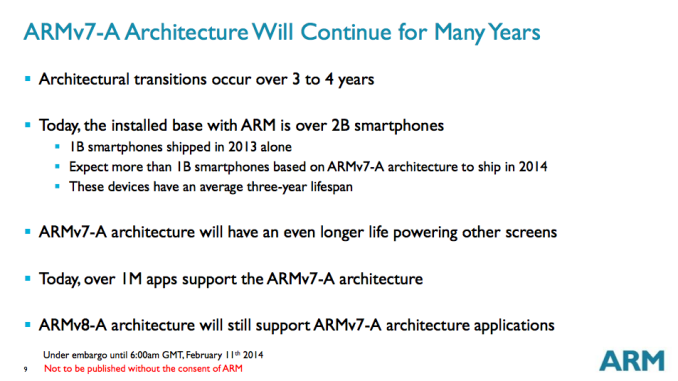ARM Cortex A17: An Evolved Cortex A12 for the Mainstream in 2015
by Anand Lal Shimpi on February 11, 2014 1:00 AM EST- Posted in
- SoCs
- Arm
- Smartphones
- Mobile
- Tablets
- Cortex A17

ARM has been doing a good job figuring out its PR strategy as of late. In the span of a couple of years we went from very little outward communication to semi-deep-dives on architecture and a regular cadence of IP disclosures. ARM continues its new trend today with the announcement of its 2015 mid-range CPU IP: the Cortex A17.
As its name implies, the Cortex A17 is a 32-bit ARMv7-A CPU design (64-bit ARMv8 cores belong to the Cortex A50 series - e.g. A53/A57). The best way to think about Cortex A17 is as an evolution of the recently announced Cortex A12, rather than anything to do with the Cortex A15. ARM's Cortex A17 takes the basic 2-wide out-of-order architecture of the Cortex A12 and improves it. Specific details are still light at this point, but I'm told that the front end and execution engine are similar to Cortex A12, with most of the performance/efficiency gains coming from improvements to the memory subsystem.
The result is a design that is roughly 60% faster than a Cortex A9r4 at a given frequency/process/memory interface (Cortex A12 is 40% faster than A9r4 under the same conditions). Using ARM's own DMIPS/MHz ratings I threw together a little table of relative/estimated performance ratings to help put all of this in perspective:
| ARM 2014/2015 CPU IP lineup | |||||||||
| CPU IP | Target | Estimated DMIPS/MHz | big.LITTLE | Shipping in Devices/Systems | |||||
| Cortex A57 | High-end mobile/servers | 5* | Yes (w/ A53) | 2015 | |||||
| Cortex A53 | Low-end mobile | 2.3 | Yes, LITTLE, w/ A57 | 2H 2014 | |||||
| Cortex A17 | Mid-range mobile | 4.0* | Yes, big, w/ A7 | Early 2015 | |||||
| Cortex A15 | High-end mobile | 4.0* | Yes, big, w/ A7 | Now | |||||
| Cortex A12 | Mid-range mobile | 3.5 | No | 2H 2014 | |||||
| Cortex A9 | High-end mobile | 2.5 | No | Now | |||||
| Cortex A7 | Low-end mobile | 1.9 | Yes, LITTLE, w/ A15/A17 | Now | |||||
*Estimate based on ARM's claims
On a given process node, the Cortex A17 can occupy around 20% more area than a Cortex A9 or a marginal increase over a Cortex A12 design. Running the same workload, ARM expects the Cortex A17 to be 20% more energy efficient than the Cortex A9 (race to sleep), but I'd expect higher peak power consumption from the A17. The Cortex A17 name was deliberately chosen as ARM expects to be able to deliver similar performance to the Cortex A15 (in mobile apps/benchmarks, likely not in absolute performance), but in a much smaller area and at a lower power. I can't help but wonder if this is what the Cortex A15 should have been from the very beginning, at least for mobile applications.
ARM expects many early Cortex A17 designs to be built on a 28nm process, with an eventual shift over to 20nm once the cost of that process drops. ARM supplied an interesting slide showcasing the number of transistors $1 will buy you as a function of process node:
If you're a fabless semiconductor, it looks like 28nm will be the sweet spot for manufacturing for a little while.
Keep in mind that the target market for the Cortex A17, like the Cortex A12, is somewhere in between a device like the Moto G and the latest flagship Galaxy S device from Samsung.
big.LITTLE Support
If you remember back to our analysis of the Cortex A12, the first version of the core didn't support ARM's big.LITTLE (lacking the requisite coherent interface) but a future version was promised with big.LITTLE support. The Cortex A17 is that future version. In a big.LITTLE configuration, the Cortex A17 will function as the "big" core(s) while the Cortex A7 will serve as the "LITTLE" core(s).
Rather than giving the Cortex A12 a new major revision number, ARM improved the design, added big.LITTLE support and called the finished product the Cortex A17. It's an interesting approach to dealing with the fact that ARM can rev/improve a single IP offering many times over the course of its life. In case it isn't already obvious, there won't be a big.LITTLE version of the Cortex A12.
ARM expects some overlap between Cortex A17 and Cortex A12. If a customer is looking to ship in 2014, Cortex A12 will be the only option for them in the mid-range from ARM. If a customer wants big.LITTLE or they are starting a design now, Cortex A17 is the obvious fit. I expect Cortex A17 will contribute to a relatively short lifespan for Cortex A12 in the grand scheme of things.
ARM sees some of the biggest opportunities in addressing the entry level and performance mainstream smartphone markets going forward. With the Cortex A17 aiming at the latter, ARM sees a potential market of around 450 million devices in 2015. The lack of 64-bit support makes ARM's mid-range lineup a little odd, especially considering the Cortex A53 and Cortex A57 will ensure both entry level and high-end smartphones will be 64-bit enabled. While I don't have an issue with a good mid-range device shipping without 64-bit support, I'm not sure how handset and tablet OEMs will feel. With Apple, Intel (and likely Qualcomm), embracing 64-bit-only strategies in mobile, I do wonder just how much success these A12/A17 architectures will have over the long run.
ARM tells me we should see the first devices using Cortex A17 CPU cores shipping in early 2015. Cortex A17 IP will be available to ARM customers for implementation by the end of this quarter.














41 Comments
View All Comments
Frenetic Pony - Tuesday, February 11, 2014 - link
I honestly expect an ARMV8 architecture from Qualcomm to come up and beat this in every category by early next year, probably with a dual core higher ipc/clockspeed design if recent trends are anything to go by.But, well, ARM wins either way. Their licensing model is ace, even if both Qualcomm and Apple can beat them in actual processor design they still get their money. Then again, with them primarily vendoring to Android, which is highly ISA agnostic, if another instruction set comes along with a much better deal it's conceivable that Qualcomm could switch, given enough willpower.
And considering Apple is first party everything I wouldn't rule out them being able to switch either. It would do better for ARM to get its first party stuff in order. Not that I'm saying the entry level market isn't big. Just that its low profit margin and runs on Android anyway.
Krysto - Tuesday, February 11, 2014 - link
We'll see. From rumors I've heard about Qualcomm's fall 2014 chips, they're are moving in the "8-core" direction instead, falling into the same trap they did with the S4 Pro, when they decided they needed to release a quad-core as quickly as possible "because everyone has one", even though they were far from ready to do it, with S4 Pro being either an overheating monster, or being heavily throttled in consumer products. But hey, it was quad-core!I was disappointed to see them do that then, even though their dual-core S4 was kicking ass and taking names that year. I would be even more disappointed to see them fall again for the multi-core marketing, especially since the 8-core thing has been an obvious marketing ploy from day one.
rish95 - Wednesday, February 12, 2014 - link
I thought Qualcomm explicitly came out and said that they have no interest in 8 core designs?BMNify - Wednesday, February 12, 2014 - link
"Krysto said:even though their dual-core S4 was kicking ass and taking names that year"sure about that, good luck trying to "software" decode http://www.auby.no/files/video_tests/h264_1080p_hp... with any dual cor eanything , many quad cant do it, so bring on the Octacore and run that birds.mkv test
hero4hire - Wednesday, February 12, 2014 - link
Couldn't someone run a quad +1 ala tegra3 and still have a high performance quad with the low power "idle" core? I really liked the idea of big .little but the solutions have been underwhelming at best. I do not see how 4 low power cores are truly better than 1 for a smartphone. Once you need performance just wake a big and race to sleep. Is there a technical reason a 5 core soc doesn't exist?Wilco1 - Thursday, February 13, 2014 - link
We haven't yet seen big/little solutions that worked as intended. The software is now finally ready and Samsung fixed their broken hardware, so we'll have to wait for devices using big/little the proper way.The reason for big/little is that a little core is far more power efficient than a 5th big core. Since big cores are typically several times larger than a little core, it is reasonable to have several little cores. This also improves the range of performance for the little cores and thus power efficiency.
Also to correct this common misconception: race to sleep is a very bad idea for power consumption. Every CPU is more power efficient at its lowest frequency than at its highest. So you only want to run at the maximum frequency when you absolutely have to. Since a little core is more efficient than a big core at any frequency, it is far better to run tasks on the little cores at low frequencies than run them on a single big core at a high frequency.
darkich - Tuesday, February 11, 2014 - link
Why no mention yet of the today announced MediaTek SoC with these cores? (4 A17+4 A7).I hope it gets some attention here on AT
Krysto - Tuesday, February 11, 2014 - link
Since Anandtech didn't mention it, here's a bit from SemiAccurate:> The new companion to the A17 is called the Mali-DP500 DPU or Display Processing Unit, yay new acronyms. ARM describes this one as “Processing pixels to the screen. Securing content up to the glass.” so you know it has DRM top to bottom. Yay again?
Great. ARM is bringing DRM to the masses! Effing great. Thanks again, ARM...now I really can't wait to not touch any device with a ten-foot pole using this chip.
iwod - Tuesday, February 11, 2014 - link
Is that an option? Or Comes with A17 by default.eric appla - Saturday, February 15, 2014 - link
Hi, I'm not sure how to contact you guys directly so i try here. I am very interested in comparison of chipsets when it comes to codec HW support. for example support for VP8. With WebRTC picking up so quickly this is becoming very relevant. I'll be very interesting to read more about which products support it and which not